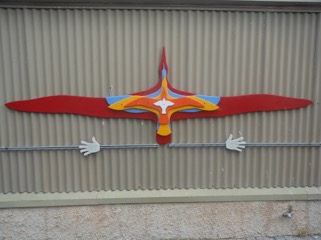The Albatross

Marita3
Mark & Helen Syrett
Wed 31 Dec 2014 02:12
| 45:50.607S 170:39.038E We drove out of Dunedin after lunch onto the spit of land called the Otago peninsula known for it’s wildlife sanctuary at the eastern tip. This is the home to NZ fur seals, blue penguins, yellow eyed penguins, red beak and black beak gulls, terns, shags and most importantly the albatross. This is another must do and its importance is in the conservation project to help this endangered bird. Unlike our penguin watching we paid for the full conducted tour with a guide and a viewing from the observation hide. The literature told us that ideally the albatross needs a strong wind to help it to fly and conditions were not ideal. We just missed the 4 pm tour which was fully booked so booked for the 4.30. There were only seven of us on our tour and we were given a half hour briefing by an excellent lady guide who was probably in her mid seventies who then led us up to the observation hide. There was no wind and she was doubtful that we would see them flying but we were assured that we would see some sitting on their nests. Sure enough from the hide we saw 3 or 4 on nests  one on a nest having a stretch  and then as the sun started to go down the wind picked up and some of the young non-nesting birds started to fly  It was extremely difficult to photograph them. The incubation period is one of the longest of any bird at 11 months and one bird stays to incubate whilst the other forages at sea. It takes 3 days for a chick to fully emerge from the shell. The parents then take turns sitting on the chick to guard it for first 30 to 40 days. They then leave the chick on it’s own and return separately to feed them every 2 to 4 days. once the chicks fledge they go off for 4 to 6 years. The parents leave the colony and go to sea for a year before returning to breed again the following year. This picture shows the size of an egg (they only lay one), a chick at two weeks and a chick at four weeks.  They, and the egg, are remarkably heavy, weighing 10 to 12 kg at 7 months with an adult bird weighing 8 to 9 kg. Perhaps the most impressive thing is the size of the adult wingspan which is up to 3 metres and it has an extra articulated bone which enables it to fly, dip, swoop, hover and dive at around 75 miles per hour. This is it’s wing span  match the coloured wing span to the coloured name below; the hands are a human’s hands outstretched.  We also saw a shag colony  and some nesting red beaked gulls  An excellent visit and well worthwhile doing the official tour. We then drove back along the Portobello Road to the camp site as freedom camping was not permitted in the area. A man in full Scottish kilt was playing the Skye boat song on the bagpipes at the waters edge! |